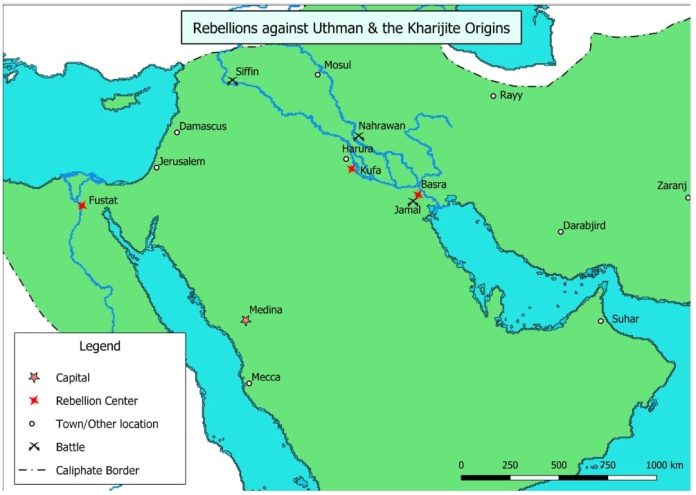
The thought process and behaviour of humans has commonalities, which is why history tends to repeat itself. Knowledge of the prophecies of the Prophet ﷺ and of causes and effects of mistakes of previous generations, is instrumental for us in avoiding the same.
A critical study of deviant sects assists to understand the tactics of misguidance by Shaytān. We shall look into one such deviant creed, the Khawārij. We shall elucidate their historical origin, evolution as a sect and as a dogma, impact on the history of Islām and repercussions on the modern Muslim civilisation. Thus, we shall ourselves endeavour to avoid their mistakes and assist others to beware of them.
There are two opinions regarding their origin. Some people opine that they originated from the army of Hazrat Alī after the Battle of Siffīn in 37 H. A group of his army revolted and separated, hence were named Khawārij, the Seceders (Fidā’ī Rafī Aḥmad, p.206). The reason being, their rejection of arbitration to end the war, thus, declining mediation between Alī and Mu‘āwiya for a peaceful compromise. Their argument being a very literal interpretation of the verse, “… Judgement belongs only to Allāh…” (Qur’ān, 06:57, 12:40, 12:67). Based on it, they declared Alī a disbeliever and 12000 people broke away from the army and set their camp at Harūrah, leading to formation of their sect.
The second opinion is that, though they were created as a sectarian movement in 37 H, their origin dates back to the time of the Prophet ﷺ, when a man called Thul Khuwairish at-Tamīmi doubted his fairness in the distribution of some gold ore from Yemen. He had the audacity to admonish the Prophet ﷺ himself, asking him to have taqwá of Allāh. This man is believed to be the first of the Khawārij (Al-Jawzee, 1985, p.22-34), a person who rebelled against the most rightful ruler of Muslims. At that moment the Prophetﷺ prophesied the coming from his tribe of such fanatics, who would be most engrossed with worship, yet they will not have the correct īmān. He ﷺ said, “…if you compare your prayers with their prayers and your fasts with theirs, you will look down upon your prayers and fasts, in comparison to theirs. Yet they will go out of the religion as an arrow… These people will appear when there will be differences among the people.” (Sahih al-Bukhari, 6933)
The prophecy did come true with the emergence of the Khawārij sect at the time of Alī’s caliphate. They proclaimed other Muslims to be disbelievers and killed their men, women and children. They were responsible for killing Alī, and the killer Abdul Raḥmān ibn-Muljam was remorseless and convinced of his cause. He happily underwent torture and died with the hope of Jannāh (Philips, A.A.B., p.11-17).
Although before his assassination, Alī defeated them in the Battle of Nahrawān in 38 H, many sects with the same ideology and dogma kept on rising across Islamic history.
There were many uprisings of Khawārij later during the Umayyād rule. Since they didn’t have the strength to openly face the strong rule of the Umayyāds, they developed tactics of guerilla warfare and continued their violent interpretation of Islam. Their bloodshed continued during the Abbāsid rule as sporadic uprisings.
A sect called the Azrakhīs with Naafi‘ ibn-al-Azraq leading them, rose around 73 H. These were the most dangerous of the Khawarīj who pronounced takfīr and killed anyone who did not agree to their ideology. Moreover, they deemed it proper to also kill such a person’s wife and children. Other sects like Ibāḍiyya and Suffrīyyah, etc. rose within the next few years.
Among the various sects, the Ibāḍiyya were comparatively mild. They did not believe that anyone, who does not confirm to their views, should be killed. Ibadis from Oman, Zanzibar, Tunisia, Algeria, Libya and Tanzania were actively involved in anti-colonial activities and politics (Ghazal, 2015). They still exist in Oman and Africa.
The Khawārij sectarian movement was finally quelled by Ḥajjāj ibn-Yūsuf (Philips, n.d.).
The roughly grouped features of ‘aqīda of these early sects were, obligation of revolting against the ruler if he did not come up to their standards of Islam, believing that major sins are never forgiven, rejecting Prophet Muḥammad’s ﷺ intercession, permitting destruction of life and property of Muslims, not following the Sunnāh properly and interpretation of the Qur’ān according to their own whims e.g., not following Rajam, etc. (Al-Izz, n.d., pp.177, 266, 326, 349)
Although the first Khawārij sectarian movement was suppressed, there still exist various other groups based on their dogma. Many extremist movements of today and of the last century can be termed as Khawārij, because their philosophy, fanaticism and harshness resemble them. Most often these are politically motivated groups that rise against legitimate governments.
As-Sallabi has quoted Ibn Hazm’s definition for them as, “Every person (dissenter) who resembles those who revolted against Alī. He quotes As-Shijistani’s definition of Khawārij as, “…who rebel against the true imām, whose appointment has been agreed upon by the Jama’a”. The definition by Dr Nasir Al-Uql is, “…who excommunicate people due to disobedience to the Creator and revolt…” (Muhammad, 2011).
Some shared traits of such groups are, not following the correct Sunnāh, holding their own opinion above that of the Salaf and breaking away from the main body of Muslims. Hussein notes in his article on how such groups resurface time and again and how their ideology influences modern extremist groups (Saleh Rahim, 2018). He mentions three common characteristics, applicable to groups of any era viz. extremism in religion, disregard for the practices of the Prophet ﷺ and fragmentation.
They are known to pronounce takfīr on fellow Muslims. In his journal article, Hassan has written about the dangers of such an ideology by using the ISIS and Al-Qaida as examples (Hassan, 2017). Most extremist movements of today and from recent history have the same tendency. The incident of the siege of Makkāh in 1977 is another example (Trofimov, 2007). Takfīr wal-hijrāh, Jāmiah Islamiyyāh of Egypt, some people from Ṭālibān, etc. continued the same ideology (Philips, 2023).
Their impact on modern day Islam has been quite significant. The image of our beautiful dīn is now firmly established with many people, as a violent, rigid and extreme religion, thanks to such misguided groups. There is protracted war, turmoil, loss of life, poverty and misery in places where such movements rise, probably that’s why they have been called “the dogs of hell”, by the Prophet ﷺ (Sunan ibn-Majah, 173).
At the end of this paper, we conclude that, the Khawārij, both in terms of the sects labelled by that name in History and in terms of their dogma in the modern Islamic world, are misguided. Though their intention may have not been to damage Islām, they have been instrumental in harming Muslims and the image of Islām. Studying about reasons of misguidance of such sects helps us save ourselves from such a path. Studying religion from the right sources, knowing the correct ʿaqīdāh and adhering to the Jama’āh can serve to save us from their fate in duniyāh and ākhirāh and can prevent harming our religion.
[The writer is based in Aurangabad, Maharashtra and a student of the International Online University, Gambia. Founded by Bilal Philips as the Islamic Online University in 2007, the university offers undergraduate and graduate degrees.]
References:
Al-Izz, I. A. (n.d.). Dar pdfs. darpdfs.org. Retrieved April 19, 2023, from https://darpdfs.org/wpcontent/uploads/2020/09/Sharh-Al-Aqidah-At-Tahawiyyah-Commentary-on-the-Creed-of-AtTahawi-Imam-Ibn-Abi-Al-Izz.pdf
Al-Jawzee, I. (1985). The Devil’s Deception (A. A. B. Philips, Ed. & Trans.; Vol. 2).
International Open University. https://iou.edu.gm
Fidā’ī Rafī Aḥmad. (1988). Concise history of muslim world (Vol. 1). Kitab Bhavan, New Delhi.
Ghazal, A. N. (2015). Tensions of nationʿalīsm: the mazabi student missions in
Tunis and the politics of anticoloniʿalīsm. International Journal of Middle East Studies, 47(1), 47–63. http://www.jstor.org/stable/43997922
Hassan, M. H. (2017). The Danger of Takfir (Excommunication): Exposing IS’ Takfiri Ideology. Counter Terrorist Trends and Analyses, 9(4), 3–12. http://www.jstor.org/stable/26351508
Muḥammad Ṣallābī ʻAlī Muḥammad. (2011). The biography of ʻAlī Ibn Abi TaʿAlīb: A comprehensive study of his personʿAlīty and era (Vol. 2). Darussalam.
Philips, A.A.B. (2023). AQD202, Module 03. Lecture. Retrieved May 15, 2023, from https://campus.iou.edu.gm/campus/mod/resource/view.php?id=4468.
Philips, A. A. B. (n.d.). Mislamic sects: Part One. International Open University. https://iu.edu.gm
Sahih al-Bukhari 6933 – Apostates – كتاب استتابة المرتدين والمعاندين وقتالهم- Sunnāh.com – Sayings and Teachings of Prophet Moḥammad (صلى الله عليه و سلم). (n.d.). https://Sunnāh.com/bukhari:6933
Saleh Rahim, D. H. (2018). The rise of the Kharijite and their influences on the contemporary
Islamist extremist groups. Journal of Social Science for Policy Implications, 6(2). https://doi.org/10.15640/jsspi.v6n2a2
Sunan ibn Majah 173 – The book of the Sunnāh – كتاب المقدمة- Sunnāh.com – sayings and teachings of Prophet Moḥammad (صلى الله عليه و سلم). (n.d.). Retrieved April 18, 2023, from https://Sunnāh.com/ibnmajah:173
The Qurʾān, 06:57, 12:40, 12:67
Trofimov, Y. (2007). The siege of mecca: The forgotten uprising. Allen Lane.




